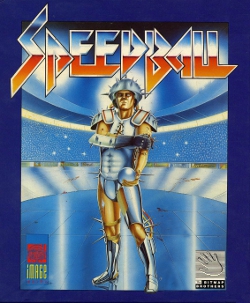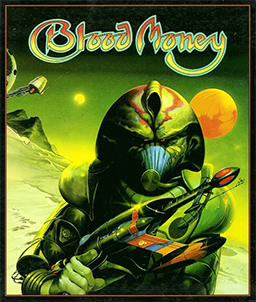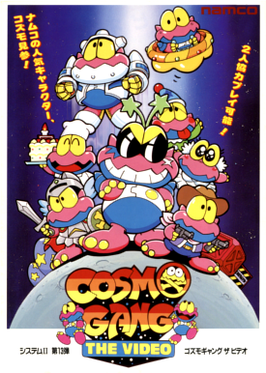
Speedball is a 1988 video game based on a violent futuristic cyberpunk sport that draws on elements of handball and ice hockey, and rewards violent play as well as goals.
Gameplay is the specific way in which players interact with a game, and in particular with video games. Gameplay is the pattern defined through the game rules, connection between player and the game, challenges and overcoming them, plot and player's connection with it. Video game gameplay is distinct from graphics and audio elements. In card games, the equivalent term is play.
Keeping up with the Joneses is an idiom in many parts of the English-speaking world referring to the comparison to one's neighbor as a benchmark for social class or the accumulation of material goods. To fail to "keep up with the Joneses" is perceived as demonstrating socio-economic or cultural inferiority. The phrase was popularised by a 1910s comic strip of the same name.

Llamatron is a multidirectional shooter video game programmed by Jeff Minter of Llamasoft and released in 1991 for the Atari ST and Amiga and in 1992 for MS-DOS. Based on Robotron: 2084, players of Llamatron control the eponymous creature in an attempt to stop an alien invasion of Earth and rescue animals—referred to as "Beasties"—for points. Players advance by destroying all of the enemies on each level using a laser that fires automatically in the direction that the Llamatron is moving. Various power-ups exist to aid the player in defeating the wide variety of enemies and obstacles they face along the way.

The Shadow of Yserbius, originally published by Sierra On-Line and developed by Joe Ybarra of Ybarra Productions, was the first of three graphical MUDs for the online community. The Shadow of Yserbius and its successors remained online until 1996, when America Online purchased the rights from AT&T for an undisclosed price. AOL soon abandoned The Shadow of Yserbius, which was a competitor to its existing online RPG Neverwinter Nights.

Walker is a horizontally scrolling shooter video game developed by DMA Design and published by Psygnosis for the Amiga in February 1993. The player controls a bipedal mech and is tasked with killing advancing enemies in stages set in multiple time periods. Development of the game began after the release of Blood Money, but was scrapped in 1990 because the game was not coming together. By the end of the year, development had recommenced with a redesign, inspired by sprites originally intended for Blood Money. Ian Dunlop and Neill Glancy designed the game, and Raymond Usher wrote its soundtrack. The game was released to positive reviews with praise directed at the game's graphics and sound, but reviewers were critical towards the repetitiveness of the gameplay. Amiga Power ranked it among their top 100 Amiga games of 1993.

Xenon 2: Megablast is a 1989 shoot 'em up video game developed by The Bitmap Brothers and published by Image Works for the Amiga and Atari ST. It was later converted to the Master System, PC-98, X68000, Mega Drive, Commodore CDTV, Game Boy, Acorn Archimedes and Atari Jaguar platforms. The game is a sequel to Xenon and takes place a millennium after the previous title. The goal of the game is to destroy a series of bombs planted throughout history by the Xenites, the vengeful antagonists of the first game.

Blood Money is a side-scrolling shooter video game developed by DMA Design and published by Psygnosis in 1989 for the Amiga, Atari ST, and MS-DOS. A Commodore 64 version followed in 1990. The game is set in four different locations on a planet, where the player must fight off enemies and bosses.

Roberta Williams' Mixed-Up Mother Goose is a computer game first released by Sierra On-Line in 1987. It is, in essence, an edutainment title, directed specifically at young gamers, as well as an adventure game. It was the first multimedia game released on CD-ROM in 1991. A second game in the series, Mixed-Up Fairy Tales, was released in 1991.

Heart of China is a 1991 adventure game developed by Dynamix and published by Sierra On-Line. The game follows the exploits of pilot Jake "Lucky" Masters as he tries to rescue nurse Kate Lomax from a ruthless Chinese warlord.
Hoyle's Official Book of Games is a series of games developed and published by Sierra On-Line. Volume 1, released in 1989, featured multi-player card games. Volume 2, released in 1990, featured 28 varieties of Solitaire. Volume 3, released in 1991, featured board games. Volume 4, was a remake of Volume 1, with two additional games. Sierra continued to publish more games to the series up to its demise. Encore Software has continued publishing entries to the series since then. According to Hoyle 1, it was essentially a spiritual sequel to Sierra's Hi-Res Cribbage (1981).

Cosmo Gang the Video is a 1992 fixed shooter arcade game developed and published by Namco. A home conversion for the Super Famicom was released the same year. Controlling the Hyper Beat starship, the player is tasked with ridding the galaxy of the Cosmo Gang, a race of aliens that cause mischief across Earth. Gameplay involves shooting enemies and avoiding projectiles. Power-up items can be collected to grant the player additional abilities. It ran on the Namco System 2 arcade board.

Space Quest IV: Roger Wilco and the Time Rippers is a 1991 graphic adventure game by Sierra On-Line. It was released on floppy disks on March 4, 1991, and released on CD-ROM in December 1992 with full speech support and featuring Laugh-In announcer Gary Owens as the voice of the narrator. It featured 256-color hand painted graphics and a fully mouse-driven interface. It was one of the first video games to use motion capture animation. It cost over US$1,000,000 to produce and sold more than its three predecessors combined. An Atari ST version was announced via Sierra Online's magazine, Sierra News Magazine, but was later canceled.

Space Quest III: The Pirates of Pestulon is a 1989 graphic adventure game by Sierra On-Line, and the third game in the Space Quest series.

Indiana Jones and the Last Crusade: The Action Game was published in 1989 by Lucasfilm Games, based on the film of the same name. The game was released for the ZX Spectrum, Amstrad CPC, Commodore 64, Atari ST, Amiga, IBM PC, MSX, Master System, NES, Game Boy, Sega Genesis and Game Gear.

Mall Madness is a shopping themed board game released by Milton Bradley in 1988.
Social simulation games are a subgenre of life simulation game that explore social interactions between multiple artificial lives. Some examples include The Sims and Animal Crossing series.

Spot: The Video Game is a video game developed and produced by Virgin Mastertronic in 1990/1991 for the Amiga, Atari ST, MS-DOS computers, Game Boy and NES. It is the first video game to feature the then-current 7 Up mascot "Spot", and was later followed up by platformers Cool Spot and Spot Goes To Hollywood.

Moonlight Madness is a platform game for the ZX Spectrum home computer, published in 1986 by Bubble Bus Software. The player controls a boy scout attempting to unlock a safe within a mansion to obtain pills for the mansion's owner, a mad scientist, who has collapsed. This requires the player to traverse the mansion's rooms while avoiding hazards such as dangerous house servants and fatal falls.
New In Town was a life-simulation social network game developed by Digital Chocolate that "allows players to customize an avatar and take another shot at life after high school, choosing a career and establishing themselves in a fictional city." The game's genre is similar to popular The Sims series but with a time mechanics based gameplay that is more reminiscent of legacy titles such as Jones in the Fast Lane.
















